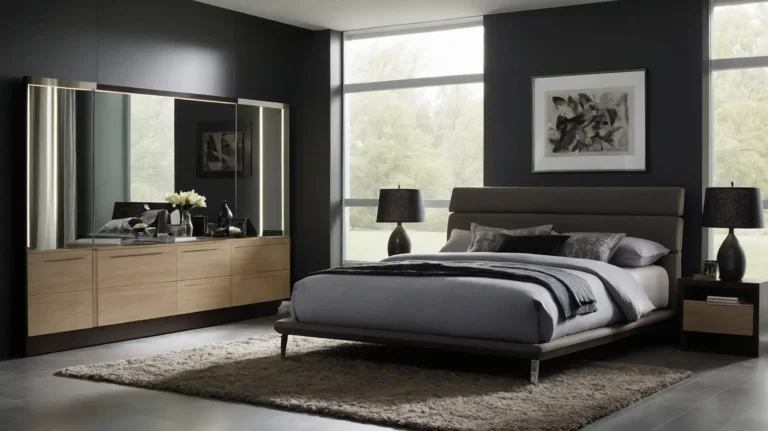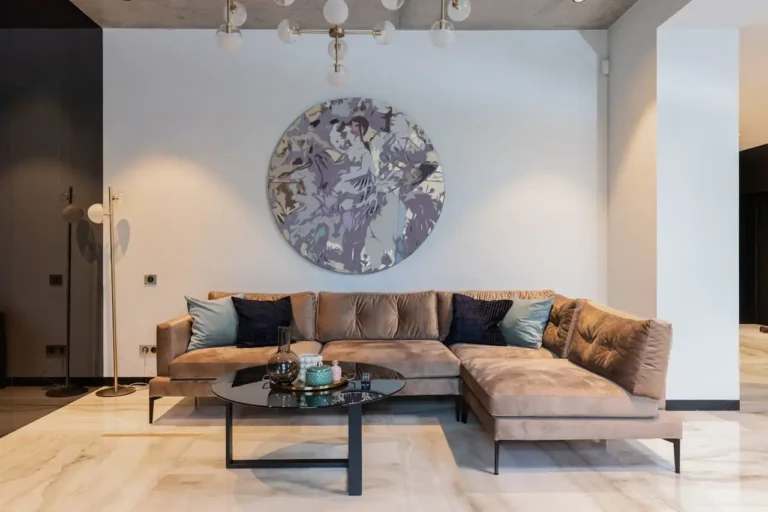27 Smart Small Living Room Ideas That Maximize Style and Space
Designing a small living room doesn’t mean sacrificing style or comfort.
With thoughtful planning and clever design tricks, even the coziest spaces can feel open, functional, and beautifully put together.
The key to small living room success lies in maximizing every square inch while maintaining an uncluttered, harmonious feel.
From multi-functional furniture to strategic layouts, the right approach transforms limitations into opportunities.
Ready to make the most of your compact living area?
Explore these 27 expert-approved ideas that will help you create a small living room that lives large and reflects your personal style.
1: Choose a Low-Profile Sofa
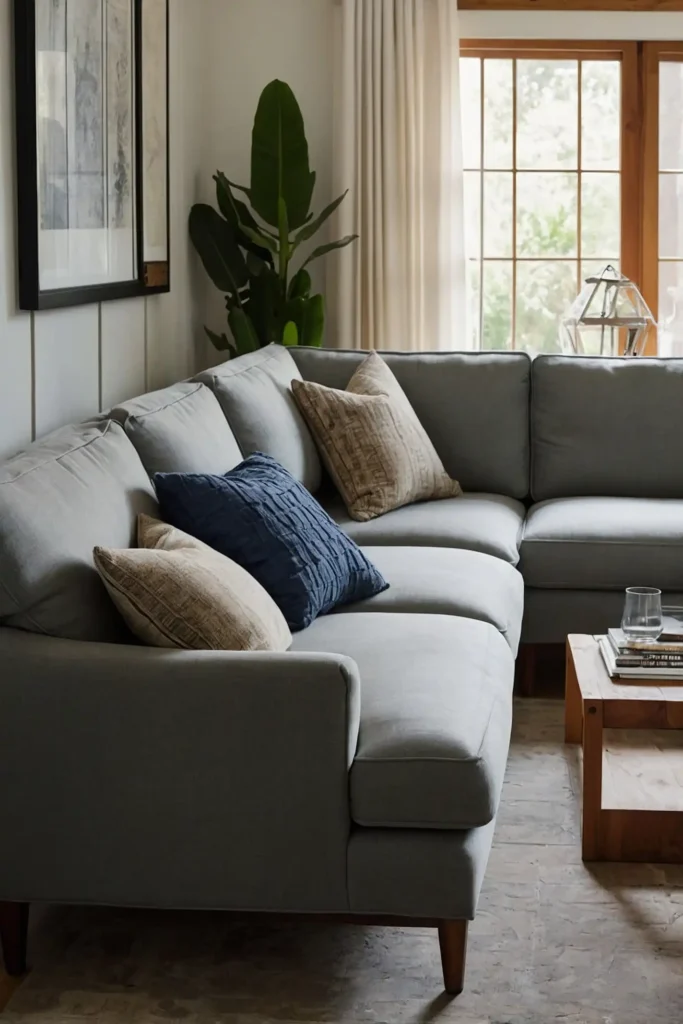
Create a sense of spaciousness with a low-backed sofa that doesn’t overwhelm your small living room.
These streamlined pieces maintain open sight lines while providing comfortable seating.
Look for sofas with exposed legs that allow you to see the floor beneath, creating the illusion of more space.
Choose compact dimensions that provide enough seating without dominating the room.
Select performance fabrics in colors that complement your space—lighter shades generally make rooms feel larger, while deeper tones add coziness and dimension.
2: Install Floor-to-Ceiling Curtains

Maximize perceived height with curtains that extend from ceiling to floor, drawing the eye upward and creating visual expansion.
This simple trick makes ceilings appear higher and rooms feel larger.
Mount curtain rods near the ceiling rather than directly above window frames for maximum effect.
Choose fabrics that blend with your wall color for a seamless look, or add subtle pattern for interest.
When open, position curtains to expose windows completely, allowing maximum natural light to fill your space—an essential element in making small rooms feel more expansive.
3: Incorporate Multi-Functional Furniture

Maximize functionality with pieces that serve multiple purposes, like storage ottomans that work as coffee tables, seating, and hidden storage compartments.
These versatile items reduce the number of pieces needed.
Consider nesting tables that can be expanded when entertaining or tucked away when not in use.
Look for sofas with built-in storage beneath cushions or convertible options for overnight guests.
These hardworking pieces eliminate clutter while ensuring your small living room meets all your practical needs without feeling overcrowded or compromised.
4: Utilize Vertical Space with Tall Bookshelves

Draw the eye upward with floor-to-ceiling bookshelves that create the illusion of height while providing valuable storage and display space.
This vertical approach maximizes often-overlooked wall real estate.
Arrange books and decorative objects with breathing room rather than cramming shelves full.
Incorporate some empty space and varied arrangements to prevent a cluttered appearance.
Paint or select bookshelves in the same color as your walls for a built-in look that visually recedes, creating a seamless expansion of your space rather than another bulky furniture piece.
5: Opt for a Glass Coffee Table

Create visual lightness with a glass coffee table that provides functionality without visual weight.
The transparent surface allows you to see the floor beneath, creating the illusion of more open space.
Choose a style with a minimal frame in metal or acrylic for maximum transparency.
The reflective surface bounces light around your room, enhancing brightness and perceived spaciousness.
Consider a round or oval shape that facilitates better traffic flow in tight spaces, eliminating sharp corners that might disrupt movement or create hazards in compact areas.
6: Use Mirrors Strategically

Amplify light and create the illusion of depth with strategically placed mirrors that reflect both natural and artificial light throughout your space.
This classic trick instantly makes rooms feel larger.
Position mirrors opposite windows to bounce maximum daylight into your room.
Consider an oversized mirror or gallery arrangement for dramatic impact and functional light enhancement.
Choose frames that complement your decor—minimalist for contemporary spaces or ornate for traditional rooms—while maintaining the reflective benefits that visually double your living area.
7: Select Furniture with Exposed Legs

Create a sense of openness with furniture that stands on visible legs rather than pieces that extend fully to the floor.
This allows you to see underneath, creating visual breathing room.
Look for sofas, chairs, and tables with slender legs that provide necessary stability without visual heaviness.
The visible floor space beneath furniture pieces makes your room appear more spacious.
This approach works particularly well with mid-century modern styles, which naturally feature the tapered legs and lighter profiles that benefit small living rooms.
8: Create a Focal Wall with Bold Color

Establish depth by painting one wall in a deeper or more vibrant color than the surrounding walls.
This creates visual interest while actually making your space appear larger through forced perspective.
Choose the wall furthest from the entrance for maximum effect, drawing the eye through the space.
Keep other walls in lighter, more neutral tones to maintain brightness and contrast.
This approach allows you to incorporate dramatic color without overwhelming your compact space, creating a designer-worthy look that adds personality and dimension.
9: Incorporate Wall Sconces or Pendant Lights

Free up precious surface space by installing wall-mounted or hanging light fixtures instead of table or floor lamps.
This lighting solution eliminates the need for side tables while providing essential illumination.
Choose adjustable options that allow you to direct light where needed for reading or ambiance.
Consider fixtures with slim profiles that provide function without visual bulk.
Incorporate multiple light sources at different heights to create layers of illumination that make your room feel more dynamic and thoughtfully designed despite its small dimensions.
10: Use Large-Scale Art

Create impact with one oversized piece of artwork rather than multiple small pieces that can make walls feel cluttered and busy.
A single large canvas or print makes a confident statement.
Choose subject matter with visual depth—landscapes, abstracts with perspective, or images with a clear foreground and background.
This creates the illusion of space extending beyond your walls.
The large-scale approach provides maximum visual interest with minimum items, contributing to the uncluttered, spacious feeling essential in small living rooms.
11: Select a Statement Rug
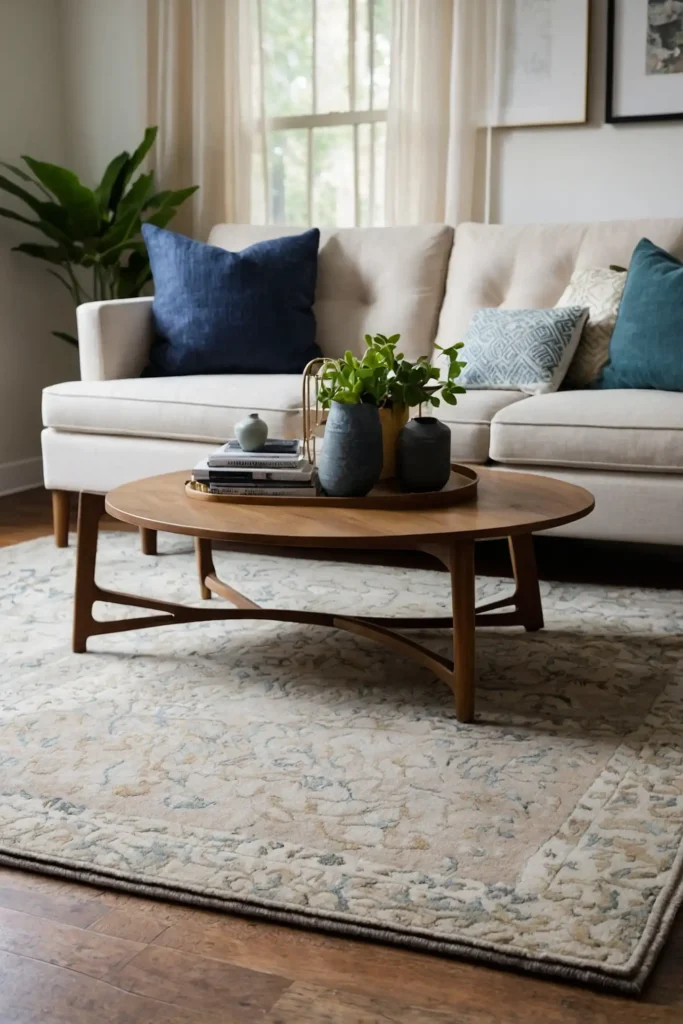
Define your seating area with a properly scaled area rug that anchors furniture while adding color and texture.
The right rug creates a sense of purpose and organization in compact spaces.
Choose a size large enough to allow front legs of all seating pieces to rest on it, creating a cohesive conversation area.
Avoid tiny rugs that make the room feel fragmented and smaller.
Consider light colors or subtle patterns that expand your space visually, or select bold designs that distract from the room’s limited dimensions by becoming a focal point.
12: Incorporate Reflective or Transparent Materials

Increase visual lightness with acrylic chairs, glass tables, or metallic accents that reflect light and appear to take up less visual space.
These materials create function without heaviness.
Mix these lighter elements with more substantial pieces for balance and comfort.
A transparent desk chair paired with a wooden table, for example, provides both solidity and airiness.
These reflective surfaces bounce light around your space, enhancing brightness and creating the sparkle that makes small rooms feel more dynamic and expansive.
13: Utilize Wall-Mounted or Floating Shelves

Maximize storage while maintaining floor space with floating shelves that provide display areas without the footprint of traditional bookcases or cabinets.
This approach keeps your floor plan open.
Install shelves in unexpected places—above doorways, around window frames, or in narrow wall sections.
These often-overlooked areas become valuable real estate in small spaces.
Style shelves with a mindful approach—curate collections carefully, incorporate some empty space, and avoid cluttering these valuable display zones with too many small items.
14: Choose Furniture with Hidden Storage

Eliminate clutter with furniture pieces that contain hidden storage compartments, like ottomans with removable tops or coffee tables with drawers.
These pieces work harder in limited spaces.
Look for sofas with under-cushion storage for extra blankets or seasonal items.
Consider platform beds with drawers beneath if your living room doubles as a sleeping area.
These clever solutions maintain a clean, minimal appearance while accommodating the practical storage needs that can otherwise overwhelm small living spaces.
15: Use a Monochromatic Color Scheme
Create visual continuity with a cohesive color palette that makes your space feel larger and more harmonious.
Limiting variation reduces visual breaks that can make a room feel chopped up.
Choose different shades and textures within your selected color family to add depth and interest.
Varied tones of blue or different textures of beige, for example, provide richness without fragmentation.
This sophisticated approach feels intentional rather than limited, transforming your small living room into a thoughtfully designed space rather than a cramped afterthought.
16: Incorporate a Wall-Mounted TV

Reclaim valuable floor space by mounting your television on the wall rather than placing it on a console or entertainment center.
This streamlined approach eliminates bulky furniture pieces.
Consider a mounting system that allows the screen to sit flush against the wall for a minimal profile.
Organize cables neatly or hide them within the wall for a clean, uncluttered look.
This space-saving solution maintains essential functionality while embracing the less-is-more approach that benefits small living rooms both practically and aesthetically.
17: Opt for Armless Seating Options

Create a sense of openness with armless chairs or sofas that eliminate visual bulk while providing necessary seating.
These streamlined pieces take up less physical and visual space.
Look for slipper chairs or armless accent chairs that can be easily moved for flexible seating arrangements.
Their lighter profiles allow for better traffic flow in tight spaces.
Mix these pieces with one armed sofa or chair for comfort and visual variety, creating a balanced seating arrangement that feels intentional rather than compromised.
18: Use Vertical Stripes

Create the illusion of height with vertical striped patterns on walls, curtains, or upholstery.
This classic design trick draws the eye upward, making ceilings appear higher.
Choose subtle tone-on-tone stripes for sophistication or bolder contrasts for more dramatic effect.
Even narrow pinstripes can create this vertical emphasis without overwhelming your space.
This visual technique works particularly well in rooms with lower ceilings, counteracting horizontal limitations by emphasizing vertical dimensions instead.
19: Consider a Loveseat Instead of a Full Sofa

Scale down proportionally with a loveseat that provides comfortable seating without the footprint of a standard sofa.
This human-scaled approach maintains function while respecting spatial limitations.
Look for designs with tailored profiles and minimal excess bulk in arms or backs.
Clean lines create less visual noise while providing the necessary comfort for daily use.
Pair with appropriately scaled accent chairs to create a complete seating arrangement that accommodates guests without overwhelming your limited square footage.
20: Create Zones with Furniture Arrangement

Define distinct functional areas within your small living room through thoughtful furniture groupings that create purpose without walls or dividers.
This approach maximizes your space’s potential.
Position your sofa to create a natural boundary between seating and walkway areas.
Angle a desk in a corner to establish a mini home office without disrupting the main living space.
These deliberate arrangements make your room work harder while actually feeling larger through clear organization and purposeful design rather than haphazard furniture placement.
21: Use Light, Cool Wall Colors

Maximize perceived space with light wall colors that reflect natural light and make boundaries recede visually.
Soft whites, pale blues, or light greens create an airy, expansive feeling.
Choose colors with slightly cool undertones that enhance the sense of openness.
Warm whites can feel cozy but sometimes make spaces feel smaller than cool-toned alternatives.
Apply your selected color to trim and doors as well as walls for a seamless look that eliminates visual breaks, creating the most spacious and cohesive backdrop for your furnishings.
22: Incorporate a Small-Scale Sectional
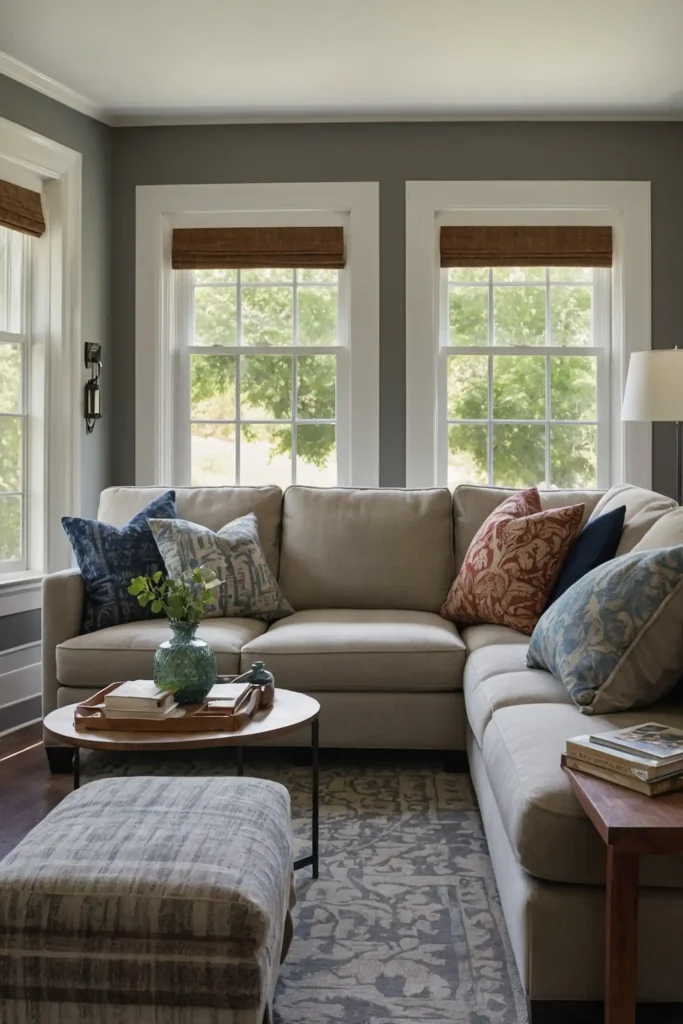
Maximize seating with a compact sectional sofa custom-sized for your small living room.
This strategic choice often provides more usable seating than a standard sofa and chair combination.
Look for shallow-depth options designed specifically for smaller spaces.
These proportionally appropriate pieces provide comfort without protruding too far into your limited floor area.
Choose L-shaped configurations that hug walls and corners, using your room’s perimeter efficiently while creating a natural conversation area in the center of your space.
23: Use Double-Duty Furniture Pieces

Maximize functionality with versatile pieces like a storage bench that serves as extra seating, a place to stage items, and hidden storage.
These multi-taskers eliminate the need for multiple specialized pieces.
Consider a desk that works as a sofa table or dining surface when needed.
Look for nesting side tables that can be expanded for entertaining and tucked away when not in use.
These adaptable solutions ensure your small living room meets all your practical needs without requiring separate furniture pieces for each individual function.
24: Create the Illusion of Higher Ceilings

Draw the eye upward with vertical design elements that make ceilings appear higher than they actually are.
Tall, narrow bookshelves, vertical wall paneling, or high curtains create visual height.
Position art slightly higher on walls than you might in larger spaces.
This simple adjustment forces the gaze upward, emphasizing vertical dimensions rather than limited horizontal space.
Consider ceiling treatments like subtle stripes or a color slightly lighter than your walls to create depth and the impression of greater height in your compact living area.
25: Incorporate Built-In Seating

Maximize every inch with custom window seats or banquettes that transform underutilized areas into functional seating with storage beneath.
These built-ins use space more efficiently than freestanding furniture.
Design these elements to follow your room’s architecture, creating seamless integration rather than interrupting the flow with additional furniture pieces.
Include hidden storage beneath cushions for maximum utility.
This approach creates the custom, thoughtful feeling of larger homes while actually addressing the specific challenges of limited square footage more effectively than standard furniture.
26: Use Fewer, Larger Accessories

Create impact with a few substantial decorative items rather than numerous small accessories that create visual clutter.
One large vase makes a cleaner statement than multiple tiny figurines.
Choose pieces with presence that can be appreciated from across the room.
Oversized books, substantial pottery, or larger plants create focal points without the busy feeling of small collectibles.
This curated approach maintains personality and style while contributing to the uncluttered, spacious feeling essential for small living rooms to feel intentional and comfortable.
27: Incorporate Lightweight, Movable Furniture

Create flexibility with easily movable pieces that adapt to different needs and occasions.
Lightweight side tables, ottomans, or stools can be repositioned as needed for entertaining or everyday use.
Look for nesting tables or stacking stools that can be expanded when you have guests.
Consider wheeled options that move effortlessly when you need to reconfigure your space.
This adaptable approach allows your small living room to evolve throughout the day or week, accommodating various activities without feeling constrained by permanent, heavy furniture arrangements.
Conclusion
Your small living room holds tremendous potential when approached with creativity and intention.
By implementing these space-enhancing strategies, you’ll create a room that feels spacious, functions beautifully, and reflects your personal style without compromise.




